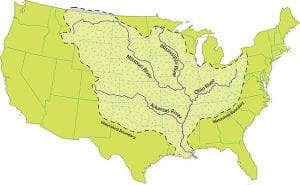For two decades, the U.S. has looked to corn as a renewable source of energy and alternative to oil. But recent research shows that corn is a little less green than we thought.
TLDR: Corn held promise as a green fuel and the government adopted policies to support that.
In the early 2000s, the federal government wanted to decrease our dependence on foreign energy sources. To make this shift, the government adopted policies that supported domestic energy production of ethanol, a fuel made from corn. These initiatives also helped develop a green energy market in the United States.
At the time, ethanol had promise as a green fuel with the potential to help the U.S. meet fuel economy standards and reduce carbon emissions. Lawmakers, therefore, implemented programs to increase our supply of ethanol. One of these was the 2007 Energy Independence and Security Act (EISA). The Act requires a certain volume of ethanol to be blended into the gasoline we buy at the gas station. It also sets annual targets to steadily raise the amount of ethanol blended into gasoline, so the U.S. eventually reaches 36 billion gallons of ethanol (up from the original 9 billion) by 2022. Such ambitious targets made ethanol central to the future of green energy.
Since then, a few things have changed…
TLDR: New research highlights significant consequences of those policies for water quality.
The increase in ethanol production was not without consequences. New research highlights significant implications of those policies for water quality in the Mississippi River Basin, a region of the central United States that stretches from Minnesota to Louisiana.

Mississippi River Watershed: https://commons.wikimedia.org/w/index.php?search=Mississippi+River&title=Special:MediaSearch&go=Go&type=image
A study in Environmental Science & Technology found that policies – like the EISA – drive the conversion of “idle” land into cropland to grow corn. As a consequence, more fertilizer is being applied to land and the risk for nutrient runoff has increased.
Corn is a nitrogen intense crop. Since corn plants remove so much nitrogen from the soil, farmers need to apply nitrogen — in the form of fertilizers — to their cornfields each year. Despite technology that helps farmers apply precise amounts of nitrogen to their crops, not all of the nutrients are taken in by plants. What is leftover “leaches”, or flows out of the soil as runoff, into waterways.
Nutrient runoff is an ongoing concern for states along the Mississippi River. For example, the findings of this research are directly connected to ongoing issues related to water pollution in my home state of Minnesota. Nitrogen runoff is very common in the Minnesota River Valley, a region dominated by agriculture in the southwest part of the state. The Minnesota River sits as the very beginning of the Mississippi River, meaning any nitrogen runoff eventually makes its way into the Mississippi River Basin.
The state of Minnesota has struggled for years to effectively address the problem since holding a single farmer accountable for actions on their cornfield can be difficult. Existing programs, such as the voluntary Minnesota Water Quality Assurance Program, have failed to curb the problem. And Minnesota is not alone. Excess nitrogen from all of the states bordering the Mississippi is an ongoing concern. Runoff from all of the states is funneled into the Gulf of Mexico, where it contributes to a growing dead zone.
A “dead zone” is an area of water that has a low concentration of oxygen. This condition — known as hypoxia — occurs when excess nutrients pollute the water, use the available oxygen, and suffocate other organisms. This year, the dead zone in the Gulf of Mexico is currently 6,334 square miles or almost the size of 6 Rhode Islands. Nearly 4 million acres of habitat are unlivable for fish and other aquatic species.
TLDR: Growing perennials, not corn, could lead to a significant reduction in nutrient leaching and land-use conversion.
The research makes it clear we need to adjust ethanol fuel policies to support perennial crops, not corn. Policies, such as the EISA, that mandate higher volumes of corn-based ethanol to be blended into gasoline, have exacerbated nitrogen runoff.
But the researchers recommend a solution: growing perennials like switchgrass or miscanthus could lead to a significant reduction in nutrient leaching and land-use conversion. Both of these plants are not typically grown as row crops and, unlike corn, they do not require yearly replanting or nitrogen application.
Adjusting federal ethanol volume mandates, the researchers find, might encourage more farmers to plant perennials. But a shift won’t be easy. The researchers admit that lessening our dependence on corn would be a difficult transition. Corn-based ethanol has an established market, whereas perennial-based ethanol’s is still emerging.
All of this does not mean we should boycott ethanol; plants can still be a renewable energy source. But it is going to be perennials, not corn, which make a greener future possible.